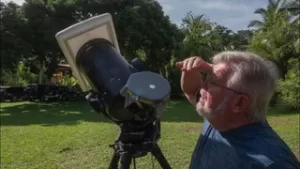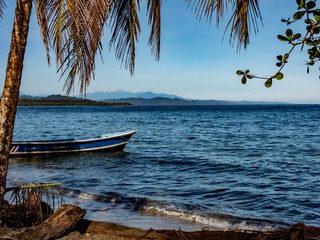One of the tenets of eclipse chasing is to always plan a wonderful trip around the eclipse, so if the weather does not cooperate, you still have a great vacation. As seasoned eclipse chasers, we started planning, and booked reservations, for the October 14th Annular Eclipse in January, months before it became news. Reviewing the possible sites, I chose Punta Uva just north of Manzanillo. It was to have one of the longest viewing times, October is the driest month there, and it is one of the most beautiful beach areas on the Caribbean coast. I knew of Cabinas Ogulitas Place ( https://olguitasplace.com/ ) from past birding trips there and booked the entire place.
A group of 11 friends, all Birding Club of Costa Rica members, embarked on a long weekend that explored many of the wonderful things to do and see in the Southern Caribbean. Plus, the Great Costa Rican Eclipse.
We left early on Thursday, taking 2 extra hours to drive around Volcan Barva since Rt 32 was closed due to landslides (it really would not be open much over the next 5 days and we had to also return the long way ). Our first stop was the Centro Manu. (https://www.centromanu.com/ ).
Manu is a beautiful little oasis of forest in the mainly deforested area around Guapiles. It is an area for hiking, picnics, and groups to enjoy the forests, but also for one of the rare birds to see in Costa Rica: The Bare-necked Umbrella Bird. They are members of the Cotinga family, and there are only three species, one in the Amazon, one in the Equator, and one in Costa Rica and Panama. Named for their strange comb over hairstyle, they spend the dry season up in the mountains, but come down in the rainy season to the lowlands. It did not take long to spot one and we were lucky to see 3 of them together, including one male with a red throat.
We completed our drive to Cabinas Olgulita’s Place in Punta Uva, which would be our base for the weekend and the eclipse. We settled into the sweltering heat and did some quite successful birding around the cabinas in the morning.
The next morning, we visited The Kekoldi Hawkwatch ( https://kekoldi.org/ ). Adjacent to the national park, it is indigenous land that hosts the nonprofit organization. A warm walk up almost 200 meters brought us to the tower, which is in the midst of reconstruction, but still a tad shaky to climb.
The Hawk watch is amazing. This area is a choke point for hundreds of thousands of migrating raptors, concentrating them as they fly by between the ocean and the Talamanca mountains going into Panama. You stand there and see nothing. Then one raptor appears, then ten more, then hundreds more and thousands more as they lower from the clouds. We watched hundreds and hundreds of Broad-winged Hawks, Mississippi Kites, Turkey Vultures, and Great Black Hawks migrate by. The local indigenous came and taught us a few Bribri words, and treated us to locally grown chocolate drinks and roasted plantain.
That night we joined Jason, the club’s current leader, and 5 more club members who were staying with him at Tierra de Suenos, (https://tierradesuenoslodge.com/ ) operated by him and his wife Callie, for dinner and discussed birds and eclipse preparations
Saturday was THE big day. The Great Costa Rican Eclipse. It was also unfortunately Global Big Day – the one day a year all birders go out to count what birds they see. We did our part in the morning finding about 40 species around the grounds as we started to set up, witnessing the early morning takeoff of the threatened Great Green Macaws.
We had the grounds between the cabins for ourselves, and just beyond the entrance, thousands started gathering on all the beaches from Puerto Viejo to Manzanillo. By 10 am you could not drive or park anywhere.
At 10:16 we saw First Contact, when the moon takes its first bite out of the sun. Equipped with welding goggles, special glasses, and filters for cameras, telescopes, and binoculars, we watched as the moon progressed, eclipsing the sun. As we watched the eclipse progress, we had fun with shadows and projecting the crescent shape of the sun as it got thinner and thinner. As the sun disappeared, the day darkened and the temperature started to drop.
At 12:04, as predicted, the last of the sun was eclipsed by the moon, called 2nd contact, allowing us to see Bailey’s Beads, a series of points of light also called the string of pearls, caused by the mountains and valleys of the moon. You could hear the cheers and applause from the thousands on the beach as the sun reached annularity – The Ring of Fire. The Eclipse lasted for a little over 2 minutes and ended with 3rd contact, a blaze of beads, and even the purple chromosphere of the sun, a real rarity for annular eclipses. What a success!

We celebrated with the traditional champagne toast and goodies, relaxing in the shade as the final crescent shadows were cast on the way to 4th contact when the moon no longer shadows the sun. Afterward, we headed for dinner, many of us abandoning our cars and walking to the restaurant because of the gridlock of thousands of cars leaving for home.
On our final day we visited Cachulta National Park for some snorkeling. Snorkeling? Costa Rica is no Belize or Bonaire or Coral Triangle when it comes to coral reefs, but there are a few areas of reef in the parks and even a reintroduction program for staghorn coral. You must take a boat and a guide to the reef areas that were surprisingly not bad at all. If in the area, I would recommend going out – the fish assemblage is nice and the waters are calm and warm, unlike the Pacific.
Leaving early due to the Rt 32 closure, we headed home. Even without the eclipse, the Southern Caribbean part of Costa Rica is a wonderful place to visit with wildlife, snorkeling, beautiful white sand beaches, and lodging and restaurants for all budgets and tastes. If you have not traveled there – you should pay a visit. JTNDZGl2JTIwc3R5bGUlM0QlMjJwb3NpdGlvbiUzQXJlbGF0aXZlJTNCcGFkZGluZy10b3AlM0FtYXglMjg2MCUyNSUyQzIyNHB4JTI5JTNCd2lkdGglM0ExMDAlMjUlM0JoZWlnaHQlM0EwJTNCJTIyJTNFJTNDaWZyYW1lJTIwc3R5bGUlM0QlMjJwb3NpdGlvbiUzQWFic29sdXRlJTNCYm9yZGVyJTNBbm9uZSUzQndpZHRoJTNBMTAwJTI1JTNCaGVpZ2h0JTNBMTAwJTI1JTNCbGVmdCUzQTAlM0J0b3AlM0EwJTNCJTIyJTIwc3JjJTNEJTIyaHR0cHMlM0ElMkYlMkZvbmxpbmUuZmxpcGh0bWw1LmNvbSUyRnZ6Y2ltJTJGd3R0YyUyRiUyM3AlM0Q3MCUyMiUyMCUyMHNlYW1sZXNzJTNEJTIyc2VhbWxlc3MlMjIlMjBzY3JvbGxpbmclM0QlMjJubyUyMiUyMGZyYW1lYm9yZGVyJTNEJTIyMCUyMiUyMGFsbG93dHJhbnNwYXJlbmN5JTNEJTIydHJ1ZSUyMiUyMGFsbG93ZnVsbHNjcmVlbiUzRCUyMnRydWUlMjIlMjAlM0UlM0MlMkZpZnJhbWUlM0UlM0MlMkZkaXYlM0U=






